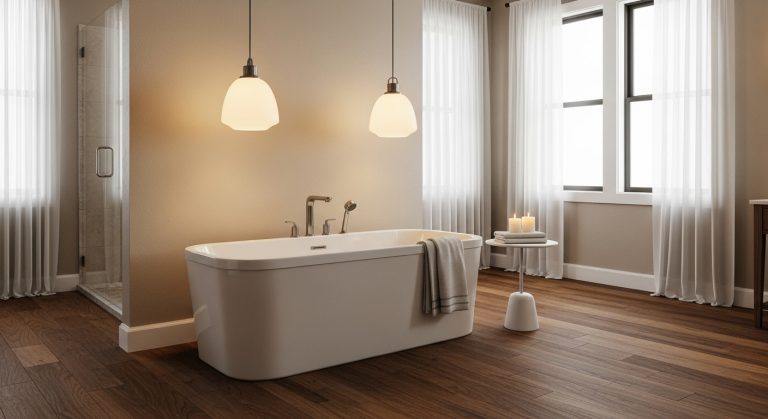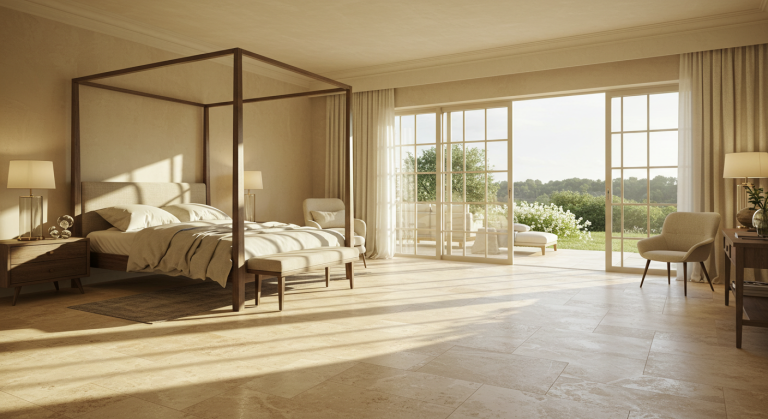Bathroom Flooring Ideas: Complete Guide for 2025

The bathroom is one of the most important spaces in any home. It’s where function meets style, and the right flooring plays a huge role in both. Bathroom flooring must be waterproof, durable, easy to maintain, and stylish — a tricky balance to achieve. Unlike other rooms, bathrooms face daily exposure to moisture, humidity, and heavy foot traffic, which makes flooring choice critical.
In 2025, homeowners have more bathroom flooring options than ever before — from classic ceramic tiles to modern waterproof vinyl and even luxury stone finishes. This article will guide you through the best bathroom flooring ideas, their pros and cons, costs, installation options, and design trends to inspire your next remodel.

Key Factors to Consider for Bathroom Flooring
Before choosing bathroom flooring, think about:
- Water Resistance: Bathrooms are wet zones; waterproof or water-resistant flooring is essential.
- Durability: Flooring must withstand daily use, humidity, and temperature fluctuations.
- Slip Resistance: Safety is a priority — textured finishes help reduce slipping.
- Style: Flooring should match your bathroom’s design, from modern minimalism to vintage charm.
- Budget: Flooring costs vary widely — from budget vinyl to high-end marble.
- Comfort: Some materials feel cold underfoot, while others offer warmth.
Best Bathroom Flooring Options
1. Ceramic and Porcelain Tile
Tile has long been the most popular bathroom flooring choice.
Pros:
- 100% waterproof
- Wide range of colors, patterns, and finishes
- Durable and long-lasting
- Works with underfloor heating
Cons:
- Can feel cold underfoot
- Slippery if polished
- Grout requires cleaning
Best For: Classic, timeless bathrooms; small powder rooms; high-moisture areas.

2. Luxury Vinyl Flooring (LVP & LVT)
Luxury vinyl planks and tiles have become a top trend in bathrooms due to their durability and affordability.
Pros:
- 100% waterproof
- Mimics wood or stone at a lower price
- Comfortable underfoot
- DIY-friendly installation
Cons:
- Less eco-friendly than natural materials
- Can dent under heavy furniture
Best For: Modern bathrooms, budget-friendly remodels, and family homes.

3. Natural Stone (Marble, Slate, Travertine, Granite)
Stone brings luxury and timeless elegance to bathrooms.
Pros:
- Unique, natural beauty
- Extremely durable
- Adds property value
- Works with heated floors
Cons:
- Expensive (both material and installation)
- Can be slippery when polished
- Requires sealing and maintenance
Best For: Luxury master bathrooms, spa-like retreats, and upscale renovations.

4. Engineered Wood Flooring
While solid hardwood is not recommended for bathrooms, engineered wood can work with proper sealing.
Pros:
- Warmer and more natural than tile or vinyl
- Stylish and elegant look
- Adds warmth to design
Cons:
- Only water-resistant, not waterproof
- Requires careful sealing and maintenance
Best For: Half-bathrooms and powder rooms with minimal water exposure.

5. Laminate Flooring (Water-Resistant Versions)
Laminate is generally not used in bathrooms, but modern water-resistant laminates are making it possible.
Pros:
- Affordable alternative to wood
- Easy installation
- Available in many styles
Cons:
- Still vulnerable to standing water
- Cannot be refinished
Best For: Guest bathrooms or budget-friendly remodels.

6. Concrete Flooring
Polished or stained concrete is gaining popularity in modern bathrooms.
Pros:
- Extremely durable
- Waterproof when sealed
- Minimalist and industrial aesthetic
- Works with radiant heating
Cons:
- Cold and hard underfoot
- Professional installation required
Best For: Modern, industrial, and minimalist bathrooms.

7. Cork and Bamboo Flooring
Eco-friendly homeowners are turning to cork and bamboo.
Pros:
- Sustainable and renewable materials
- Warm and soft underfoot
- Naturally resistant to mold and mildew
Cons:
- Must be sealed properly
- Not ideal for heavy water exposure
Best For: Eco-conscious bathroom designs, powder rooms.

Bathroom Flooring Costs (2025 Guide)
| Flooring Type | Material Cost (per sq. ft.) | Installed Cost (per sq. ft.) |
|---|---|---|
| Ceramic Tile | $2 – $7 | $8 – $15 |
| Porcelain Tile | $3 – $10 | $10 – $20 |
| Luxury Vinyl Plank | $2 – $6 | $5 – $10 |
| Natural Stone | $7 – $20 | $15 – $40 |
| Engineered Wood | $4 – $12 | $8 – $16 |
| Laminate (Water-Res.) | $2 – $5 | $6 – $10 |
| Concrete | $4 – $8 | $8 – $15 |
Bathroom Flooring Design Trends for 2025
- Large Format Tiles – Fewer grout lines, modern sleek appearance.
- Matte Finishes – Reduces slips and looks elegant.
- Wood-Look Vinyl & Tile – Warmth of wood, durability of vinyl/tile.
- Bold Patterns & Geometric Designs – Adds character to small bathrooms.
- Natural Stone Finishes – Marble and slate remain timeless choices.
- Heated Flooring Systems – Luxury comfort for cold climates.
- Eco-Friendly Options – Sustainable cork, bamboo, and recycled materials.
Installation Tips for Bathroom Flooring
- Always use a moisture barrier under flooring.
- Choose slip-resistant finishes for safety.
- Professional installation is recommended for stone, tile, and concrete.
- For DIY-friendly options, go with click-lock vinyl or laminate.
- Invest in heated floors if choosing cold surfaces like tile or stone.

Maintenance Tips
- Wipe up spills immediately.
- Use mats near tubs and sinks.
- Avoid harsh cleaners that damage sealants.
- Reseal stone and engineered wood regularly.
- Sweep and mop with recommended cleaning products.

FAQs About Bathroom Flooring
Q1: What is the best waterproof bathroom flooring?
Porcelain tile and luxury vinyl are the most reliable waterproof options.
Q2: Which bathroom flooring is the most durable?
Natural stone and porcelain tile are the most durable long-term.
Q3: What flooring is safest for bathrooms?
Textured tile or matte finishes reduce slips better than polished stone.
Q4: Can I put wood flooring in a bathroom?
Yes, but only engineered wood with proper sealing and minimal water exposure.
Q5: How long does bathroom flooring last?
- Tile: 20–50 years
- Vinyl: 15–25 years
- Stone: 50+ years with maintenance
- Engineered wood: 15–20 years
Conclusion
Choosing the right bathroom flooring is about balancing practicality, style, and budget. While ceramic and porcelain tile remain the gold standard, luxury vinyl, stone, and even concrete are rising stars in 2025. The key is selecting a floor that is waterproof, durable, and safe while enhancing your bathroom’s design.
Whether you’re aiming for a spa-like retreat with marble, a budget-friendly remodel with vinyl, or a modern industrial look with concrete, the flooring you choose will set the tone for years to come.



